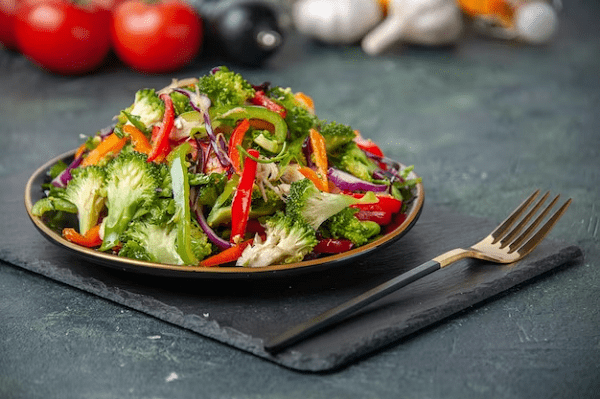Salads- Salads are versatile dishes that typically consist of a mixture of vegetables, fruits, proteins, and other ingredients, often topped with a dressing. They can be served as a side dish or as a main course, and their ingredients can vary widely based on personal preferences, cultural influences, and seasonal availability. Here are some common types of salads and their key ingredients:
- Green Salad:
- Ingredients: Lettuce, spinach, arugula, kale, or other leafy greens.
- Additional Ingredients: Tomatoes, cucumbers, carrots, radishes, and other fresh vegetables.
- Caesar Salad:
- Ingredients: Romaine lettuce, croutons, Parmesan cheese.
- Dressing: Caesar dressing made with ingredients like anchovies, garlic, Dijon mustard, and olive oil.
- Greek Salad:
- Ingredients: Tomatoes, cucumbers, red onions, olives, and feta cheese.
- Dressing: Olive oil, lemon juice, oregano, and sometimes red wine vinegar.
- Cobb Salad:
- Ingredients: Iceberg lettuce, tomatoes, bacon, hard-boiled eggs, avocado, and chicken or turkey.
- Dressing: Typically served with blue cheese dressing.
- Caprese Salad:
- Ingredients: Tomatoes, fresh mozzarella cheese, and basil.
- Dressing: Usually drizzled with balsamic glaze or a simple vinaigrette.
- Nicoise Salad:
- Ingredients: Tuna, hard-boiled eggs, tomatoes, olives, and green beans.
- Dressing: Often with a vinaigrette made from olive oil, Dijon mustard, and red wine vinegar.
- Fruit Salad:
- Ingredients: Assorted fruits such as melons, berries, grapes, and citrus.
- Optional: Mint leaves or a drizzle of honey for added flavor.
- Chicken Salad:
- Ingredients: Cooked and shredded chicken, mixed with celery, grapes, or apples.
- Dressing: Mayonnaise or yogurt-based dressing with herbs and spices.
- Quinoa Salad:
- Ingredients: Cooked quinoa, mixed with vegetables like bell peppers, cherry tomatoes, and cucumber.
- Optional: Add feta cheese or olives for extra flavor.
- Asian Noodle Salad:
- Ingredients: Cooked noodles, mixed with vegetables like bell peppers, carrots, and snow peas.
- Dressing: Soy sauce, sesame oil, rice vinegar, and ginger.
Salads can be customized based on dietary preferences, and they offer a healthy and refreshing option for meals. Feel free to experiment with different ingredients and dressings to create your own unique salad recipes.
What is Salads
A salad is a dish typically consisting of a mixture of various ingredients, usually vegetables, and often served with a dressing or sauce. Salads can be cold or warm, and they come in a wide variety of forms. While vegetables are often a key component, salads can also include fruits, nuts, seeds, grains, proteins (such as meat, poultry, fish, tofu, or legumes), and cheeses.
Salads are known for their versatility, and they can be customized based on personal preferences, dietary restrictions, and cultural influences. They are popular as both side dishes and main courses, and they can range from simple green salads to more complex and hearty creations.
Common types of salads include green salads, which feature leafy greens and assorted vegetables; pasta salads, where pasta is combined with vegetables and sometimes proteins; and fruit salads, which include a variety of fresh fruits. Caesar salad, Greek salad, and Cobb salad are examples of specific salad recipes with distinct ingredients and dressings.
Dressings for salads can vary widely, ranging from simple vinaigrettes made with oil and vinegar to creamy dressings made with mayonnaise or yogurt. The dressing often adds flavor and moisture to the salad.
Salads are valued not only for their taste but also for their nutritional content, as they are often rich in vitamins, minerals, fiber, and antioxidants. They provide a refreshing and light option for meals, especially during warm weather.
Who is Required Salads
“Salads” is not a person; rather, it refers to a category of food. A salad is a dish typically made by combining various ingredients such as vegetables, fruits, greens, nuts, seeds, proteins, and dressings. The term “Salads” in your question doesn’t represent an individual or entity. If you have a specific person or context in mind, please provide more details, and I’ll do my best to assist you.
When is Required Salads

Salads are not associated with a specific time in the way that events or appointments might be. Salads are a type of food, and they can be enjoyed at any time, whether it’s as a refreshing side dish for lunch or dinner, a light meal for breakfast, or a snack.
If you have a specific context or if you’re asking about a particular event related to salads, please provide more details, and I’ll do my best to help!
Where is Required Salads
The term “salads” does not refer to a specific location. Salads are a type of food, typically consisting of a mixture of vegetables, fruits, proteins, and other ingredients, often served with a dressing. You can find or make salads virtually anywhere in the world, as they are a common and versatile dish enjoyed in various cultures and cuisines. Salads can be prepared at home, ordered at restaurants, or found in grocery stores and food markets. They are not associated with a specific geographic location but are rather a widely consumed and adaptable culinary concept. If you have a more specific question or context, please provide additional details, and I’ll do my best to assist you.
How is Required Salads
If you’re asking about how to make salads or how salads are prepared, it depends on the type of salad you’re interested in. Here’s a general guide on how salads are typically made:
Basic Steps for Making a Simple Salad:
- Choose Your Greens:
- Start with a base of fresh greens. Common choices include lettuce, spinach, arugula, or mixed greens.
- Add Vegetables:
- Chop or slice vegetables of your choice. Common options include tomatoes, cucumbers, bell peppers, carrots, and radishes.
- Incorporate Extras:
- Add extras for flavor and texture, such as avocado, nuts, seeds, or croutons.
- Include Proteins:
- If you want to make the salad a complete meal, add proteins. This could be grilled chicken, shrimp, tofu, chickpeas, or hard-boiled eggs.
- Dress It Up:
- Prepare a dressing or use a store-bought one. Common dressings include vinaigrettes, ranch, Caesar, or yogurt-based dressings.
- Toss It Together:
- Combine all the ingredients in a bowl and toss them together to distribute the flavors and dressing evenly.
- Garnish (Optional):
- Garnish with fresh herbs, cheese, or additional toppings for extra flavor.
Example Recipe: Classic Caesar Salad
Ingredients:
- Romaine lettuce
- Croutons
- Grated Parmesan cheese
- Caesar dressing
Instructions:
- Wash and chop the Romaine lettuce.
- Add croutons for crunch.
- Sprinkle grated Parmesan cheese.
- Pour Caesar dressing over the top.
- Toss the ingredients together until well coated.
Feel free to customize salads based on your preferences and dietary needs. The beauty of salads is their versatility, so you can get creative with ingredients and flavors.
Case Study on Salads
FreshChoice Salads – Navigating the Salad Delivery Market
Executive Summary:
Background: FreshChoice Salads, founded in 2022, is a startup company aiming to capitalize on the growing demand for healthy and convenient food options. The company specializes in delivering customized salads to customers’ doorsteps, allowing them to choose from a diverse range of fresh ingredients and dressings.
Objectives:
- Market Penetration:
- Establish FreshChoice Salads as a leading provider of customizable salad deliveries in urban areas.
- Healthy Lifestyle Promotion:
- Promote healthy eating habits by offering nutritious salad options with transparent ingredient sourcing.
- Operational Efficiency:
- Streamline supply chain and delivery processes to ensure freshness and reduce environmental impact.
Market Analysis:
Trends:
- Increasing health consciousness among consumers.
- Growing demand for convenient, on-the-go meal options.
- Emphasis on sustainable and locally sourced ingredients.
Competitive Landscape:
- Competition from established salad chains and local restaurants.
- Opportunity to differentiate through customization and health-focused branding.
Consumer Research:
Preferences:
- 72% of surveyed consumers prefer salads with a mix of greens and protein.
- 85% prioritize freshness and quality of ingredients.
Challenges:
- Concerns about the environmental impact of packaging.
- Need for effective marketing to distinguish from competitors.
Business Model:
Customization Platform:
- Online platform allowing customers to build their salads.
- Subscription options for regular deliveries.
Supply Chain:
- Partnerships with local farmers for fresh produce.
- Sustainable packaging solutions.
Marketing Strategy:
Branding:
- Emphasize the health benefits of salads and customization options.
- Highlight FreshChoice Salads’ commitment to sustainability.
Digital Marketing:
- Social media campaigns promoting healthy living.
- Collaborations with fitness influencers and nutritionists.
Results:
Initial Successes:
- Positive customer reviews for freshness and taste.
- Growing subscriber base for regular salad deliveries.
Challenges:
- Addressing environmental concerns through research into eco-friendly packaging.
- Continuous efforts to differentiate from competitors in a saturated market.
Future Outlook:
Expansion:
- Consideration of expansion to additional cities.
- Introduction of new menu items and seasonal offerings.
Innovation:
- Research and development of sustainable packaging solutions.
- Integration of technology for a more personalized customer experience.
This fictional case study provides a glimpse into the challenges and opportunities that a startup specializing in salad deliveries might face in a competitive market. Real-world case studies would involve detailed market research, financial analysis, and ongoing adjustments to the business strategy based on feedback and changing market trends.
White paper on Salads
“Revolutionizing Health and Taste: The Art and Science of Salads”
Executive Summary:
Salads have emerged as a symbol of healthy living, offering a perfect blend of nutrition and gastronomic pleasure. This white paper explores the evolution of salads, the science behind their health benefits, and the innovative trends shaping the salad industry.
I. Introduction:
A. Historical Perspective:
Salads have a rich history dating back centuries, evolving from simple combinations of greens to today’s diverse and customizable creations.
B. Global Salad Culture:
Analyzing the cultural significance of salads worldwide and their adaptation to different cuisines.
II. The Science of Salads:
A. Nutritional Powerhouse:
Detailing the nutritional benefits of salads, emphasizing their role in providing essential vitamins, minerals, and fiber.
B. Health Impact:
Exploring the impact of salads on weight management, cardiovascular health, and overall well-being.
C. Ingredient Selection:
Understanding the science behind selecting diverse and nutrient-rich ingredients for a balanced salad.
III. Trends Shaping the Salad Industry:
A. Customization and Personalization:
Examining the rise of customizable salad options and their appeal to modern consumers seeking unique and tailored dining experiences.
B. Sustainability:
Addressing the industry’s commitment to sustainable practices, including responsible sourcing, reduced food waste, and eco-friendly packaging.
C. Technology Integration:
Investigating the role of technology in salad preparation, from online customization platforms to smart farming practices.
IV. Challenges and Solutions:
A. Environmental Impact:
Analyzing the challenges related to packaging waste and exploring sustainable alternatives.
B. Market Saturation:
Discussing strategies for standing out in a market saturated with salad offerings, including branding, marketing, and unique menu options.
V. Case Studies:
A. Success Stories:
Highlighting successful salad-focused businesses and their strategies for market penetration and customer retention.
B. Lessons Learned:
Examining challenges faced by some salad ventures and deriving insights for future entrepreneurs.
VI. Future Prospects:
A. Emerging Ingredients:
Exploring potential future ingredients and culinary trends influencing the evolution of salads.
B. Technology Advancements:
Anticipating how technology, such as hydroponics and AI-driven customization, might shape the future of salad production and consumption.
Conclusion:
Summarizing the key findings, this white paper emphasizes the enduring appeal of salads as a nutritious, customizable, and sustainable culinary choice. As technology advances and consumer preferences evolve, salads remain at the forefront of the intersection between health and taste, offering a canvas for culinary innovation and a pathway to a healthier lifestyle.
Industrial Application of Salads
While salads are typically associated with home and restaurant kitchens, there are industrial applications of salads in certain contexts, particularly in the food processing and catering industries. Here are a few examples:
1. Food Processing and Packaging:
- Pre-packaged Salads: Industrial food processors often prepare pre-packaged salads for supermarkets and convenience stores. These salads may include a mix of fresh vegetables, proteins, and dressings, all prepared and packaged using industrial-scale equipment.
2. Catering for Large Events:
- Bulk Salad Preparation: When catering for large events such as weddings, conferences, or corporate gatherings, industrial kitchens may prepare salads in bulk quantities. This involves efficient chopping, mixing, and packaging processes to meet the demands of a large number of attendees.
3. Airline Catering:
- In-Flight Salads: Companies specializing in airline catering produce salads for in-flight meals. These salads must adhere to specific guidelines for freshness, packaging, and transportation.
4. Hospital and Institutional Food Services:
- Mass Meal Preparation: Large-scale food service operations in hospitals, schools, and other institutions often prepare salads as part of mass meal production. This involves industrial-grade kitchen equipment to handle significant quantities.
5. Fast Food Chains:
- Salad Production for Fast Food: Fast-food chains with a focus on healthier options often prepare salads on an industrial scale. This includes centralized preparation of salad components for distribution to multiple locations.
6. Frozen Salad Products:
- Frozen Salad Options: In some industrial food processing settings, salads are prepared and then frozen for later consumption. These frozen salads offer convenience and an extended shelf life.
7. Meal Kit Services:
- Component Preparation: Companies that provide meal kits may utilize industrial processes for washing, cutting, and packaging salad components to be included in their kits.
8. Supply Chain Management:
- Supplying Ingredients to Restaurants and Retailers: Industrial-scale farms and food suppliers may provide bulk quantities of salad ingredients to restaurants, retailers, and other food service providers.
9. Salad Dressing Production:
- Mass Production of Dressings: Industrial-scale production of salad dressings involves mixing, blending, and packaging dressings for widespread distribution.
10. Research and Development:
- Ingredient Innovation: Research and development facilities within the food industry may explore new varieties of salad ingredients, innovative packaging solutions, and methods to extend the shelf life of pre-prepared salads.
These industrial applications highlight the scalability and efficiency required to meet the demands of large-scale food production, distribution, and catering while maintaining the quality and freshness associated with salads.





